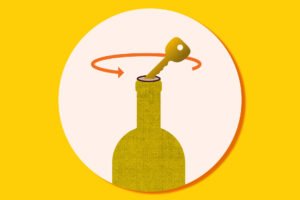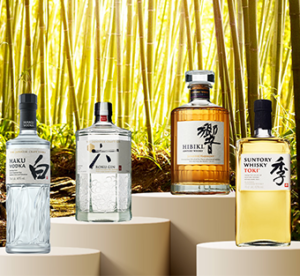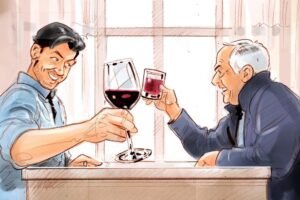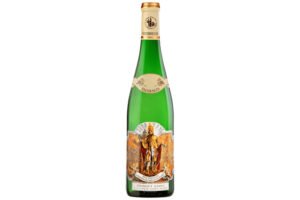Banfi: America’s Gift to Italian Wine

[ad_1]
Traditionally, Italians have emigrated to the US, but for one New York family it’s a different story.
Cristina Mariani-May is the daughter of John Mariani, who along with his brother Harry, founded the Banfi wine brand in the 1970s with their purchase of the former Poggio alle Mura estate in Montalcino. Today, Banfi is one of the most famous and recognized of all Brunello producers, and Mariani-May serves as the company’s CEO and President.
We recently interviewed her to learn her family’s and her own personal story as Americans who broke new ground in Italy. Other topics we discussed included everyday work with her team in Italy, as well as the accomplishments that she is most proud as she continues to lead Banfi in the ever-competitive domain of Brunello di Montalcino.
Tell us a little about how Banfi got its start.
My grandfather brought his two sons, John and Harry, into the family import business, which was blossoming into fine wines and everyday wines. In 1978, from the success of that, they ventured back to Italy and paired up with Ezio Rivella (a renowned Tuscan enologist).
They thought we can either buy a winery, or we can do something ourselves. When they looked at wineries with Ezio, they thought that this area is so steeped in tradition, you know, like this is the way we do it here. I think as a New Yorker and a wine importer, my father thought, “wait, we can do this ourselves”.
They started Castello Banfi from scratch from virgin soil, and today we have 7100 acres that is a contiguous property. It’s big, but in 1978, there was nothing there. There may have been 20 Brunello producers back then, and most of them sold their wine locally. Even Biondi Santi, my dad tried to import it, but they told him they didn’t have enough wine to export it to America.
My father said there’s a great potential for Brunello, so let’s invest in this territory, and because we were Americans also, we understood wine marketing and global consumers, so we had a very global approach to a territory that was steeped in tradition and hadn’t blossomed yet.
What was the reaction of the locals in Montalcino?
The locals when we first moved in, and I’ll base this on history – I’m third generation and I don’t sense it – but the thought was, “who are they? What are they doing? Are they crazy?”
You know, these crazy New Yorkers coming in. But our entire team was Italian. Ezio headed that team. What we did over time, we were doing all this research, the clonal research. We narrowed this down from 650 Sangiovese clones down to 15. We registered that work, so we were the only single producer in Italy to register our clonal work with the Italian government.
So what we in essence are doing is sharing our research, sharing the methods, documenting it all, so everybody can utilize it, and everybody can rise with the tide. When we started doing that and opening our doors to the research that was going on, that sentiment really changed.
It changed to the degree that people said “Oh, thank you.” Because if Banfi had made a better wine in 1978, no way that the world of Brunello is put on a global map. You need the whole territory to be making outstanding wines. We were the catalysts, the renaissance. Biondi-Santi in the beginning and then we came through decades later and I’d like to think of that as a rebirth. Everybody is prosperous now, it’s all planted out now, it’s one of the most popular noble red wines of Italy, and so we all kind of benefit. So, I think that the tide has changed.
How often do you spend time in Italy?
Probably once a month. I go for a week to 10 days. Now Covid stopped that, which is weird. But I’ve already been back to Italy. It’s my home away from home, but I will not deny I am not a winemaker, we have our team. I’m the owner and we work with our team, and it’s so simple now from a business and wine angle to have good communications, but there’s nothing in Italy like being face to face, especially in the wine culture.
In wine, you need to stop and appreciate. You want to have a meal, you want to talk through strategy, the philosophy, the research, the experiments you want to invest in. It takes years to see them come into fruition. You have to be a long-term planner with vision and strategy.

© Castello Banfi
| New York’s Mariani brothers took over the Poggio alle Mura estate in 1978 and turned it into a Brunello powerhouse.
What do you see is your strongest input to the company?
I try and just bring the passion and the inspiration, because I believe in it so much, the work that we’re doing. Not only for the community but for the greater wine world. I mean it, in our little corner, our little niche, we’re putting in a lot of energy and investment and there are good times and bad, highs and lows. My responsibility is to carry on through and bring the team up and elevate all of us. I like to think I’m the greatest cheerleader. That’s what I do, I love what I do. I’m blessed this was given to me by my father. I’d like to pass it on to my kids. That’s kind of what I do.
I represent the winery and deal with top managerial decisions, which is not the fun part of the job. I’m a female manager, I don’t dictate, I work with the team together, let’s decide what’s best for the wines and the brands.
Do you sit down and taste blends with them and give them your thoughts?
I do and that’s the fun part of the job. Every time I’m there we’re sitting down and tasting barrel samples and fresh, fermented wines. Do I give input on how I want the style should be? Absolutely. Do they know that by now? Yes, but they’re the experts on the blending. As a team, we all agree that this is the best version of a Super Tuscan or Brunello.
We don’t make different wines for different markets. That’s one thing of which we all agree. I do not want a sweeter wine for the United States and a drier version for Asia. This is the wine, we make it on a global palate, and then we market it in different ways in different markets obviously.
What are your thoughts on the 2015 and 2016 vintages, which were consecutive excellent years?
It’s a tough call, but I have to say that 2016 felt calmer and better. We were coming off such a beautiful harvest the year before and our expectations were kind of lowered because you assumed one good harvest and then you fall back and then you jump forward.
So, I think we were kind of calm, thinking this is not going to be as outstanding, but as the season went on and on and it was consistent, and then it got cooler, and it was perfect growing conditions. Honestly, everyone was so excited when the grapes were finally picked. We were joyous because here we are coming off such a great vintage another good one – this felt like a blessing.
What are you most proud of, both in terms of your input as well as the Banfi story?
I’m really proud of the foresight and vision my father had that I’m able to carry on through. He had a vision of pure and natural wines from the beginning. I’m so proud today that we’re dedicated to sustainability; we document a report every year about research and sustainability that’s very thick. It’s shared throughout all the universities.
I’m so proud of our team. We have the Foundation Sangue di Jove, which is dedicated to research on Sangiovese; both in the winter and summer, we come together and invite winemakers, sommeliers, you name it, and we do a conference on the leading findings of Sangiovese. It’s a big deal, and for the community, we’re so proud to continue that.
I’m also very proud of the vision of hospital of hospitality and welcoming guests. We now have a hotel, Il Borgo, which is Relais and Chateaux. We have a Michelin star at our restaurant. We host a jazz festival, with musicians coming from all over the world. It’s the way we do things for the territory and the community – I’m very proud of that.
What keeps you going? What drives you?
I love to travel, and I love new people. I have a wanderlust, so that drives me a lot. I love new experiences. I can’t sit still, I never have.
What keeps me going is that sense of adventure and learning something new everywhere I go. It might be a new market or a place to visit or people I meet. I love it, I don’t want to sit at home. I want to be out in the world.
[ad_2]




